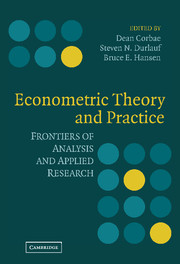Book contents
- Frontmatter
- Contents
- Preface: In Praise of a Remarkable Teacher
- Contributors
- Introduction
- PART I HIGHER-ORDER ASYMPTOTICS
- PART II IV SPECIFICATION TESTS
- PART III NONSTATIONARITY
- PART IV LAD AND QUANTILE REGRESSION
- 9 On Efficient, Robust, and Adaptive Estimation in Cointegrated Models
- 10 Testing Stationarity Using M-Estimation
- 11 Consistent Specification Testing for Quantile Regression Models
- PART V NONSTATIONARY PANELS
- Index
10 - Testing Stationarity Using M-Estimation
Published online by Cambridge University Press: 05 June 2012
- Frontmatter
- Contents
- Preface: In Praise of a Remarkable Teacher
- Contributors
- Introduction
- PART I HIGHER-ORDER ASYMPTOTICS
- PART II IV SPECIFICATION TESTS
- PART III NONSTATIONARITY
- PART IV LAD AND QUANTILE REGRESSION
- 9 On Efficient, Robust, and Adaptive Estimation in Cointegrated Models
- 10 Testing Stationarity Using M-Estimation
- 11 Consistent Specification Testing for Quantile Regression Models
- PART V NONSTATIONARY PANELS
- Index
Summary
INTRODUCTION
There is a large body of literature in time series econometrics on the debate over whether economic time series are best characterized as trend stationary processes or difference stationary processes. Since the influential article by Nelson and Plosser (1982), hundreds of economic time series have been examined by unit root tests (against a stationary alternative) or stationarity tests (against a unit root alternative). Refer to Meese and Singleton (1982); Perron (1989); Schotman and van Dijk (1991); Phillips (1991); Zivot and Andrews (1992); Gil-Alana and Robinson (1997) among others. Despite the large body of literature on unit root tests, there have been several attempts at testing (trend) stationarity (Park 1988; Park and Choi 1988; Rudebusch 1988; Kwiatkowski et al. 1992; Leybourne and McCabe 1994; Fukushige, Hatanaka, and Koto 1994). In particular, Kwiatkowski et al. (1992) (hereafter KPSS) considered a time series model that can be decomposed as the sum of a deterministic trend, a random walk, and a stationary error, and they proposed Lagrange multiplier (LM) test for the null hypothesis of stationarity. Leybourne and McCabe (1994) suggested a similar test that differs from the KPSS test in its treatment of autocorrelation and applies when the null hypothesis is an AR(k) process.
The primary purpose of this chapter is to propose a unified view for testing stationarity. Our test is general and has power against a wide range of alternatives that are of possible econometric interest.
- Type
- Chapter
- Information
- Econometric Theory and PracticeFrontiers of Analysis and Applied Research, pp. 266 - 287Publisher: Cambridge University PressPrint publication year: 2006

